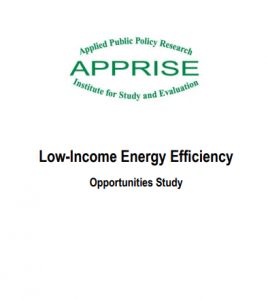Full Title: Low-Income Energy Efficiency Opportunities Study
Author(s): Charlie Jiang
Publisher(s): Applied Public Policy Research Institute for Study and Evaluation (APPRISE) and Environmental Defense Fund (EDF)
Publication Date: December 1, 2017
Full Text: Download Resource
Description (excerpt):
Equity through energy efficiency:
Report outlines benefits and pathways to expanded low-income energy efficiency
As the country moves to a cleaner energy system, many low-income Americans have been left behind.
A new report from the EDF and Applied Public Policy Research Institute for Study and Evaluation (APPRISE) details the huge opportunity from increased investment and focus on low-income energy efficiency and outlines key steps to get there.
A win-win with energy savings for all:
Well-designed energy efficiency programs that deliver cost-effective energy savings for low-income Americans can cut utility bills by hundreds of dollars per year.
These programs can also create jobs, reduce pollution, improve public health, and promote equity. Yet only 6 percent of all U.S. energy efficiency spending was dedicated to low-income programs, as of 2015.
Smart policies to expand energy efficiency programs for low-income Americans could result in:
– $7.4 billion worth of consumer electricity savings annually.
– 48 million tons of carbon pollution avoided each year, equivalent to taking:
– 9 million cars worth of emissions taken off the road.
– Pathways to success
– State and utilities can realize this significant opportunity by implementing policies and programs targeted specifically for low-income customers.
A new report finds that these programs can be designed to overcome obstacles many low-income Americans face in accessing energy efficiency — including credit requirements, language barriers, and structural deterioration of homes.
The study finds that best practices for states to successfully deploy low-income energy efficiency programs include aligning utility incentives with goals, coordinating funding sources, partnering with community leaders, and focusing on high-energy users.
